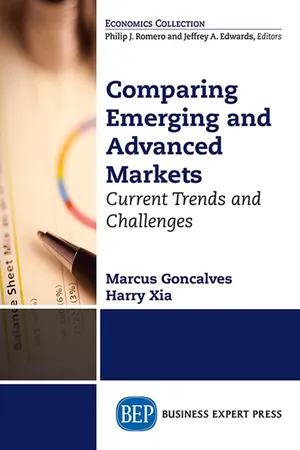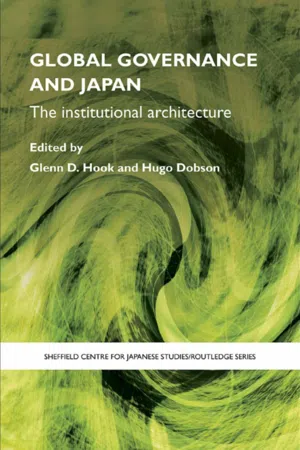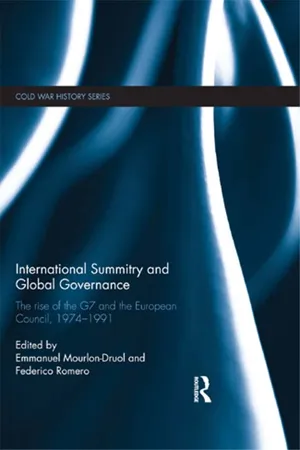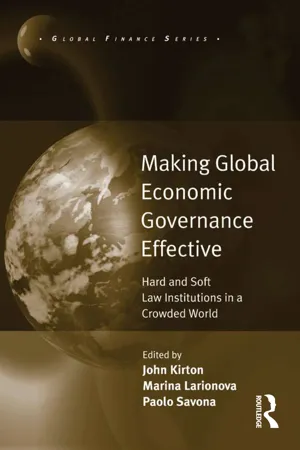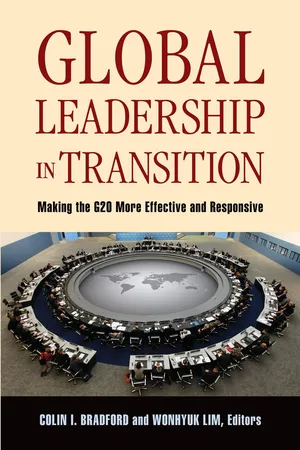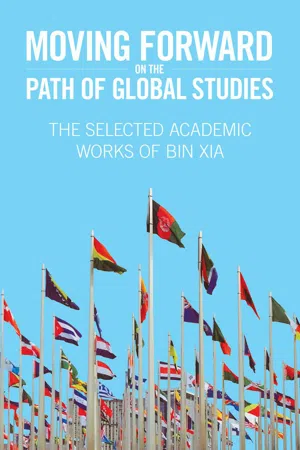Politics & International Relations
G7
The G7, or Group of Seven, is an intergovernmental organization consisting of Canada, France, Germany, Italy, Japan, the United Kingdom, and the United States. It was formed in 1975 to discuss economic issues and coordinate policies among its members. The G7 also addresses global challenges such as climate change, security, and development.
Written by Perlego with AI-assistance
Related key terms
Related key terms
1 of 4
Related key terms
1 of 3
9 Key excerpts on "G7"
- eBook - ePub
- Marcus Goncalves, Harry Xia(Authors)
- 2014(Publication Date)
- Business Expert Press(Publisher)
Canada , Japan, Italy, and Germany. The G-7 was renamed as the G-8 during 1997, when Russia was added to the original seven-country lineup. Ever since its inception, the G-7 and G-8 asserted several political and economic policies, which affected other countries.The G-7 and G-8 became known in the international scene as the major policy-makers, which could enforce or disrupt political and economic stability. The latest installment of the G-8 is called the G-20, a greater coalition formed in 1999 that included the nations of Brazil , China, Saudi Arabia, Republic of Korea, France, Australia, China, Canada , Germany , Indonesia, Argentina, Turkey, India, Russia, South Africa, Mexico, Japan, United Kingdom, United States, and the European Union.While the G-20 is supposed to acknowledge all members as equals, it cannot be denied that the countries, which were included in its G-8 predecessor, have an advantage over other countries in terms of political and economic policy-making. So far, the G-20 goals for 2014 are to focus on growth and resilience.G-20 country growth strategies contain a mix of macroeconomic and structural reforms at the domestic level that suit each country’s circumstances in areas with the greatest potential to lift global growth:• Increasing quality investment in infrastructure. - eBook - ePub
- Michael R Hodges, John K. Kirton, Joseph P. Daniels(Authors)
- 2019(Publication Date)
- Routledge(Publisher)
To still others, it is a club that has not lived up to its potential in the 1990’s, due to a false new consensus that its leaders lack the power to perform its core functions of macroeconomic management in a world where markets and multinationals dominate (Bergsten and Henning, 1996). Gone is the recent optimism that heralded the G7 as a governing global concert at the dawn of the post-cold war decade (Lewis, 1991-2; Odum, 1995). There are few who proclaim its centrality, effectiveness or even potential now (Bayne, 1995; Ionescu, 1995; Kirton and Kokotsis, 1998).The prevailing pessimism, however, stands in sharp contrast to the observed proliferation and performance of the G7 over the past decade. From 1989 onward Russia has been admitted, ultimately as a full member, many other countries have become associated through a variety of innovative mechanisms, and several contenders, for reasons of status and function, continue to quietly press their case for inclusion. The G7’s agenda has expanded as the linked economic and political issues that inspired its creation have been joined by a host of subjects once considered entirely domestic but which now clearly call for a coordinated transnational response on a global basis.With the broadened agenda has come deeper institutionalization, domestic engagement and participation by civil society actors. Indeed, the annual gathering of the leaders is now supplemented by a year-round sequence of ad hoc meetings of the leaders and their finance and foreign ministers, regular forums collectively embracing a majority of the ministries of government, and a subterranean web of working groups that even the leaders’ personal representatives find it difficult to monitor and control.Finally, despite periodic delays and disappointments, the G7 of the past decade has produced substantial achievements in international co-operation, constraining its members’ behaviour in accordance with its collective commitments, and responding to the major crises of the moment. In short, as the post cold war, globalizing world of the 1990s moves into the new millennium, the G7 and now Group of Eight (G8) is emerging as an effective centre, and is prospectively the effective centre, of global governance. - eBook - ePub
Global Governance and Japan
The Institutional Architecture
- Glenn D. Hook, Hugo Dobson(Authors)
- 2007(Publication Date)
- Routledge(Publisher)
Although the G7 was originally created as a forum to deal with the turbulences in the international economy and problems of deepening interdependence during the 1970s, it now functions within the management process of a globalized political economy covering a variety of agendas and policy issues. Although Japan is politically and militarily a regional power, it has been an active participant in this global process of transition. The G7/8 seems to provide certain terms and conditions for those in power to occupy a safe and commanding position to play an active role in the management of global affairs. For example, after the cold war, the former superpower Russia was ‘allowed’ into the G7/8 because it was ‘democratized’ and had installed a full-fledged market economy. As is mentioned later, however, despite a sounding from Japan to invite China into this forum, other member states have been rather reluctant, because it is not a liberal democracy. In this way, the G7/8 has the virtual power to decide who manages and who is managed by limiting its membership and thereby informally demonstrating the international standard of political legitimacy. Through these developments, in some respects, the G7/8 controls the agenda of global concern by acting as a gatekeeper, with Japanese policymakers increasingly viewed as playing an active role in this process and the Japanese political economy as a whole occupying a significant position in it.Yet the G7/8 is not just a series of meetings among the world’s top leaders; it involves varieties of political processes and policy networks. The political economies of those advanced capitalist countries are, thus, organized into fuzzy interlocking networks of connections and influences. First, the G7/8 process involves wider bureaucratic machines and interest groups in these countries. They are quite active in attempting to influence the G7/8 negotiating process and shape what promises and pledges can and should be made. It is a formalized process through which the bureaucrats of these countries work together to bring about agreement as regards what constitutes the public agenda and general policy orientation on many issues; basically, the differing domestic policies of these countries are evaluated through agreed norms of policy orientation. Sometimes the real battle of words and ideas is fought among the bureaucrats involved. Through this process, bureaucrats from the G7/8 countries come into regular and close contact with each other, especially those working as assistants to their leaders: the sherpas. Their efforts before and during the summit meeting may create mutual confidence, private friendship and an esprit de corps - Chiara Oldani, Jan Wouters(Authors)
- 2018(Publication Date)
- Routledge(Publisher)
Both the EU and the G7 have recently been hit at the core of their ambition to increase cooperation, coordination and integration. Both bodies have lost a member in recent years: Russia was suspended from attending G8 meetings, and the UK has decided by popular referendum to leave the EU. This comes at a time when public dissatisfaction with globalization is rising with increasing momentum. Recent elections in Europe and in the US have clearly shown that these forms of discontentment need to be addressed if the world intends to remain on the path of globalization. The US and the EU, traditional supporters and architects of the current governance mechanisms that guide globalization, face particularly strong internal populist pressures. Those pressures towards less globalization must be felt in the G7 as well. However, as a global steering group (Wouters and Van Kerckhoven 2017), the G7 is also uniquely placed to address this discontent. The G7 could play a major role in countering the current threats to the global economy (Bergsten, Truman and Zetelmeyer 2017). Possible avenues include new trade and environmental initiatives, within the new political constraints. Their implementation can revive the momentum towards cooperation and will be essential to resist the spread of protectionism.At a time in which one of the leading members of the G7, the US, is led by a president who stands for a more isolationist approach, the G7 needs to be led by other members. The EU seems best placed to provide this leadership. Individual G7 members like Canada and Japan, but also the individual EU G7 members, lack the ability and influence to guide the G7.The non-UK EU members in the G7, with the exception of Italy, have so far been able to resist populist and isolationist tendencies; at the very least, political parties representing these grievances have failed to gather majority support in their parliaments. This may indicate that the electorate in these countries might still not have given up on globalization or still believes in its potential. At first sight, the exit of the UK from the EU hurts the leverage of the EU and its member states in the G7. However, at the same time, it might allow the 27 remaining EU member states to integrate more deeply and at a greater pace: in international negotiations, the UK sometimes seemed to lean closer to its transatlantic partners than to its EU fellows, obstructing the ability of the EU and the other EU members to push forward, even if perhaps also this trend could be reversed by a weaker US-UK alliance. Still, the EU needs to incorporate informal bodies such as the G7 much more comprehensively into its external strategies. While such an exercise might be difficult due to the fact that some EU member states are themselves invited to these bodies and would like to remain able to use these bodies so as to advance their own national interests, it is also true – as seen above – that the informal nature of these fora does not incentivize the EU and its member states to draft a more comprehensive strategy and to develop more extensive coordination practices. However, the EU seems ready to continue to make the G7 work. Donald Tusk, president of the European Council, said the group’s leaders ‘sometimes have very different views’ on topics such as climate change and trade, ‘but our role as the EU is to do everything to maintain the unity of the G7 on all fronts’ (European Council 2017).- eBook - ePub
- Andrew Baker(Author)
- 2006(Publication Date)
- Routledge(Publisher)
Some would see this as evidence of the decline in significance of the G7. 72 However, this is a simplistic assessment that fits rather too conveniently with the liberal institutionalist perspective’s current obsession with legalism in American IR, which views the effectiveness of institutions in terms of compliance and legal obligation. 73 This review of domestic institutional arrangements again points us in the direction of the G7 processes role in facilitating consensus formation amongst the leading industrialized powers on global financial governance issues that in turn sets parameters and guiding principles for economic policy-making more generally, and as Robert Cox has pointed out, circumscribes what can be thought and done. 74 The G7 finance ministries and central banks seek to set agendas in global financial governance by formulating their own consensus and seeking to influence debates, agendas and activities in other spatial dimensions, such as their domestic arenas, globally networked markets, and wider multilateral and transnational bodies including the governments of non-G7 states. Given their financial resources and their intellectual expertise, the G7 finance ministries and central banks reaching a common view is not something that is insubstantial, nor is it something that can be easily resisted. Simply writing the G7 off on the basis of the absence any formal decision-making capacity is to miss a significant concentration of influence in the global political economy. Ignoring the informal directional and agenda-setting influence of the G7 because it does not fit with the methodological and theoretical imperatives of certain schools of thought in International Relations is a serious oversight. Finance Ministries, Central Banks and Differing Domestic Political Economies One of the principal differences between the G7 countries in financial and monetary affairs is rooted in the different domestic political economies of G7 states - eBook - ePub
International Summitry and Global Governance
The rise of the G7 and the European Council, 1974-1991
- Emmanuel Mourlon-Druol, Federico Romero(Authors)
- 2014(Publication Date)
- Routledge(Publisher)
‘directoire’ whose decisions would commit French policy and be imposed on other countries. This was especially true after the Venice Summit (1980), where a political declaration about Afghanistan was adopted; from 1981 Reagan tried to use the G7 as a framework to forge and implement a common policy of the West towards the East, first via discussions on East–West trade, and then in 1983 through a common declaration on the Geneva negotiations which led to open conflict between Reagan and Mitterrand during the Williamsburg Summit. For Mitterrand, who had to maintain the specificity of French policy in the face of both right wing opposition and domestic communist pressure from within his own majority, showing firmness was essential.The US, by contrast, had a more institutional conception of the G7, perceiving it as a means to publicly display their leadership of the West and gain the support of allies for their political choices. Consequently, Washington stressed the political unity of the Seven, the decisions taken and their follow-up, the politicisation of summitry, and generally all the evolutions institutionalising the G7. Beyond the differences between administrations – Carter’s administration had a trilateralist project of cooperation around US leadership while Reagan’s administration was more pragmatic and unilateralist – the media strategy did not change. Just as the London Summit (1977) had been dominated by newcomer Carter,64 so the Ottawa Summit was transformed into a ‘Reagan summit’.65 At Williamsburg, despite the criticism of the Versailles Summit, Reagan’s team planned media coverage that would be even more important and extensive.66 According to French diplomat Philippe Faure, the US had a different strategy towards newspapers and television media; he noted in March 1983 that Reagan’s advisers promised to televise a very ‘coloured’ summit, with many shows and formal events. The press service of the White House, however, gave little information to newspaper journalists, as if it wanted to minimise the importance of the summit. To Faure, this was done so that the US could prepare a media ‘surge’, with pictures being more important than commentaries about the political choices discussed at Williamsburg.67 The US strategy was actually more complex and simpler. It was more complex because there was real political ambition; in the few days before the summit the main US objective became the adoption of a ‘declaration on security’ in which the Seven would take a position on the Geneva negotiations. Reagan probably hoped to avoid public disagreement with France before his summit, and he wished to impose his text during the meeting. Eventually though, his text was harshly discussed with Mitterrand on the last day and this compromised the media strategy planned by the US.68 - eBook - ePub
Making Global Economic Governance Effective
Hard and Soft Law Institutions in a Crowded World
- Marina Larionova, John Kirton(Authors)
- 2016(Publication Date)
- Routledge(Publisher)
Do the world’s major powers keep the international commitments they make? This central question of international relations has long been met with skeptical answers on many fronts. Realist scholars of international relations since Thucydides have argued that in an anarchic international system, where the strong do what they want while the weak do what they must, international institutions and commitments are only instruments through which the smart and the strong bind the stupid and the weak. Liberal institutionalist scholars, especially in their recent “legalization” phase, argue that international regimes and their principles, norms, rules and decision-making procedures do make an autonomous difference in how relative power relationships are converted into the behavior of even strong states, particularly when those regimes and their commitments are equipped with high levels of precision, obligation and delegation (Krasner 1983, Abbott et al. 2000, Ikenberry 2001). They look at the Group of Seven (G7) and now Eight (G8) Summit of major market democracies as having the lowest levels of possible precisions, obligations and delegations, implying that promises made there are unlikely to become promises kept (Abbott et al. 2000). They thus join a great array of G8 watchers and governors who claim that the G8 is merely a “photo op,” a global “hot tub party” or a “country club,” and certainly not a directoire that makes decisions that its members subsequently put into effect. A more recent generation of constructivist scholars, however, suggests that such intense direct communication among members of a small elite club can make a difference in how the otherwise isolated and individual members change and construct their conceptions of interests, and even their identity itself (Wendt 1999).The evidence suggests that G8 governance does make a difference for its members, and thus for the global community as a whole. Since its 1975 start, the G7/8’s global governance performance has embraced not just the photo op function of domestic political management by the leaders for their audiences back home, nor only the global hot tub party or country club function of deliberation to increase information, transparency, trust and the avoidance of accidental conflicts that no one wants. Rather, it has extended to the directional function of setting new principles and norms, the decisional function of collectively creating new rules or commitments, delivering on these commitments through the compliance of its members and creating new decision making procedures by developing G8-centered global governance through G8 institutions of its own. Indeed, as Appendix 5A - eBook - ePub
Global Leadership in Transition
Making the G20 More Effective and Responsive
- Colin I. Bradford, Wonhyuk Lim(Authors)
- 2011(Publication Date)
- Brookings Institution Press(Publisher)
These changes will not be the result of one leader alone. They will be the result of a group of leaders who control the world's power and influence working together—and together they may have the ability to effect change in people's day-to-day lives. The evolution of the G20 should not, in my view, reflect the institutions of the twentieth century, with bureaucracies and tightly scripted agendas. It should reflect the reality of today's world, including the 24/7 multimedia context in which we live and the struggle by states for sovereignty in an increasingly interconnected world.The balance to be struck is not one between global governance and the nation-state, between international and domestic agendas and the media. It is between the need to create balanced global growth and the need of every individual to hold onto his or her way of life in the midst of modernity and urbanization and challenges and opportunities that know no borders.The PEW Global Attitudes project, an annual survey based on interviews with thousands of people in dozens of countries, has long noted that while people like what globalization brings them in terms of medicine, technology, and food, at the same time they remain anxious about the pace of change and potential loss of cultural identity. That tension was evident throughout the evolution of the G20, and it remains today.The Historical PerspectiveIn 1975 a group of developed industrialized nations began a group to focus principally on economic issues. At Rambouillet, where the first summit meeting was held, the group was the G6; when the United States added Canada in 1976 to offset the preponderance of Europeans, the G7 came into being. The developed economies faced a stock market freefall and global recession in 1973–74. 1973 had been an especially tumultuous year. There was an oil crisis as a result of an OPEC-mandated oil embargo on top of the erosion of the real price of oil due to U.S. inflation. At the same time, South Vietnam weighed heavily as the United States withdrew combat troops in 1973, overwhelmed by the costs of war. The message of Rambouillet was clear. As British prime minister Harold Wilson put it, “The coming together of the six heads of government this weekend was a recognition of our shared responsibility for the recovery of the world economy.”1 - eBook - ePub
Moving Forward On the Path of Global Studies
The Selected Academic Works of Bin Xia
- Bin Xia(Author)
- 2020(Publication Date)
- Page Publishing, Inc.(Publisher)
In order to represent developing nations’ interest, international negotiation mechanisms, as an important element in international community, came into being, which aimed at helping all developing nations use peaceful consultations in a sensible way to confront and overcome global difficulties and challenges. Meanwhile, international negotiation mechanisms are striving to exterminate any economic dilemmas in any corner of the world as well as work together with other states to build a prosperous world with peace and development. With its inception in 1999, the Group of Twenty (G-20) has served as a bridge between developing nations and developed nations to encourage global economic coordination and assistance. The discussion of this paper will focus on the G-20, which provides an important platform for developing nations to boost global economic cooperation and development.How Did G-20 Come into Being? ---From G-5 to G-20Beginning in the 1970s, national leaders from five developed countries, including the United States, the United Kingdom, France, Germany, and Japan, gathered together to have an international conference on global economic issues. In the 1980s, this international forum was enlarged adding two nations that were Canada and Italy, called the G-7. In 1998, Russia was invited to join in this group, creating the G-8. Major topics during the annual G-8 summit contained economic globalization, international trade, economic relations with developing nations, and exchange rates. In addition to the G-8 summit, negotiations among foreign affairs ministers, finance ministers, and central bank governors were meetings that occurred under the leadership of G-8. After September 11, 2001, the annual G-8 summit began to discuss other transitional issues such as national security, money laundering, drugs, and terrorism.95 Because the G-8 was all made up of major developed nations all over the world, the nickname of the G-8 summit was also called the “Rich Country Club”.96On September 25, 1999, the annual conference of the G-8 finance ministers and central bank governors announced that they established a new international economic forum that would “broaden the dialogue on key economic and financial policy issues among systemically significant economies and promote cooperation to achieve a stable and sustainable global growth that benefits all.”97
Index pages curate the most relevant extracts from our library of academic textbooks. They’ve been created using an in-house natural language model (NLM), each adding context and meaning to key research topics.
Explore more topic indexes
Explore more topic indexes
1 of 6
Explore more topic indexes
1 of 4
